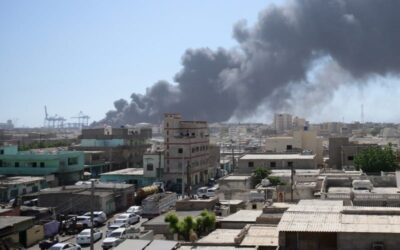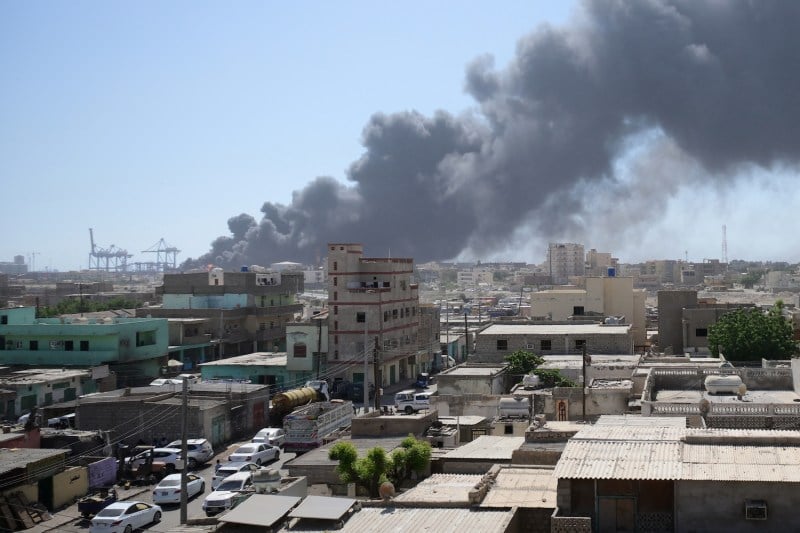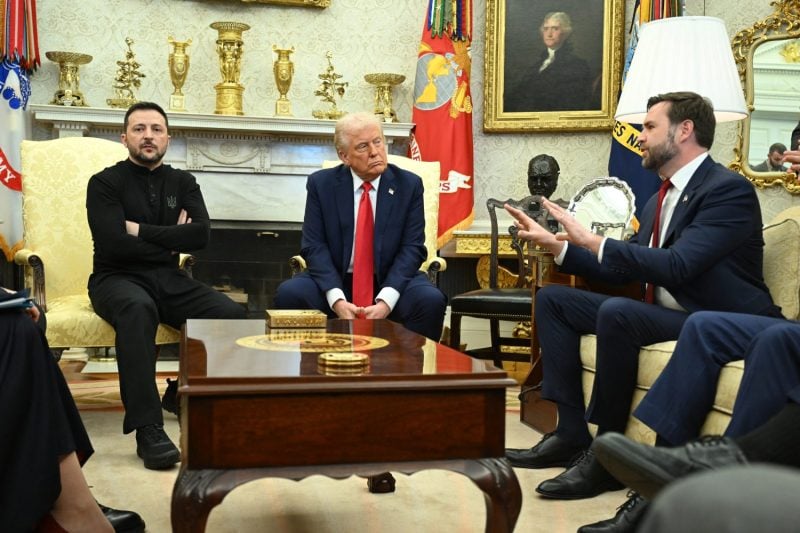India Has a Long-Term Plan With Pakistan

India Has a Long-Term Plan With Pakistan
New Delhi aims to root out cross-border terrorism, but it risks fueling discontent.
A police officer with a sniffer dog inspects a railway station during an emergency simulation drill in Hyderabad, India, on May 7. Noah Seelam/AFP via Getty Images
Welcome to Foreign Policy’s South Asia Brief.
The highlights this week: India’s strikes against Pakistan should be seen as part of a long-term plan, India and the United Kingdom sign a long-awaited free trade agreement, and former Bangladeshi Prime Minister Khaleda Zia’s return home raises questions about her son’s political future.
Welcome to Foreign Policy’s South Asia Brief.
The highlights this week: India’s strikes against Pakistan should be seen as part of a long-term plan, India and the United Kingdom sign a long-awaited free trade agreement, and former Bangladeshi Prime Minister Khaleda Zia’s return home raises questions about her son’s political future.
India’s Counterterrorism Long Game
Two weeks after terrorists gunned down 26 tourists near the town of Pahalgam in Indian-administered Kashmir, India retaliated with military action against Pakistan, which it blames for support the militants. (Islamabad denies involvement in the attack.)
Early Wednesday morning local time, airstrikes targeted nine terrorist sites in Pakistani-administered Kashmir and the neighboring province of Punjab, according to an Indian government statement. The statement also said that the strikes had avoided military targets and were intended to be nonescalatory.
Pakistan denounced the Indian strikes as an act of war, saying that they hit civilian facilities, including a mosque, and killed at least 26 people. It then immediately responded, staging heavy shelling across the countries’ disputed border in Kashmir and claiming that it downed five Indian jets. New Delhi acknowledged that at least two of its aircraft had crashed but did not elaborate.
Failing to take military action would have been politically costly for Indian Prime Minister Narendra Modi’s government, which prides itself on its tough-on-terror position and faced domestic pressure to respond with muscle given the brutality of the Pahalgam attack. India strongly telegraphed its intention to use force and in recent days test-fired missiles and ordered civil defense drills across the country.
In the coming days, attention will focus on the military dimensions of the crisis: India’s strikes constituted a high-intensity use of force against Pakistan—perhaps the biggest since the 1971 war between the two countries. But the strikes should be seen as part of a long-term plan by India that aims to root out cross-border terrorism once and for all.
Since the Pahalgam attack, India has taken nonmilitary punitive steps against Pakistan, some of them unprecedented. New Delhi cut off all imports from Islamabad, including commerce routed through third countries; closed the countries’ only land border; and suspended the Indus Waters Treaty, a transboundary water management accord, for the first time.
India is also pressuring Pakistan’s international donors to reduce assistance to the country, and it may push an influential global terrorist financing watchdog to scrutinize Islamabad’s record. By targeting its economy, exploiting its water shortages, and isolating Pakistan globally, New Delhi is playing the long game—seeking to raise the costs of Islamabad not acting against terrorists targeting India.
India’s multifaceted attempt to squeeze Pakistan is likely motivated by a realization in New Delhi that earlier tactics to curb cross-border terrorism—including limited military action—were insufficient. Further, given the nuclear deterrent and Pakistan’s conventional force capabilities, India’s military options are relatively limited beyond the types of actions that it carried out on Wednesday.
Ultimately, this long-term strategy will be ambitious. India-Pakistan trade was so limited to start with that cutting it off won’t have major economic effects. And it won’t be easy to isolate Pakistan, since its closest friends (China and Saudi Arabia) and other key partners (the United States, Qatar, the United Emirates, and Turkey) are influential global actors, and it belongs to multilateral forums that have its back.
In cases where India can really inflict pain—such as long-term efforts to build infrastructure that prevents water from flowing into Pakistan—it may make Islamabad more embittered, prompting it to strengthen ties to anti-India actors. Such actions may also galvanize militants themselves: Feared Pakistan-based group Lashkar-e-Taiba has previously cited Indian “water theft” while threatening attacks against India.
The main takeaway is that India’s relations with Pakistan, after four years of relative calm, appear to be headed for a deep freeze.
The two countries face the immediate risk of a limited conflict—but beyond that, Pakistan will likely be targeted by a multipronged pressure campaign meant to curb a threat that India has struggled to tame.
What We’re Following
India inks trade deal with U.K. On Tuesday, Modi and British Prime Minister Keir Starmer announced a new free trade agreement after three years of discussions. The deal will reportedly ensure that 99 percent of India’s exports to the United Kingdom receive zero tariffs, meaning that duties will drop on goods including alcohol, cars, cosmetics, and medical devices.
The deal will result in an estimated annual trade increase of 25.5 billion British pounds ($33.9 billion), according to the U.K. Last year, the countries’ bilateral trade volume was nearly 43 billion British pounds ($57 billion). With so much attention on India’s trade talks with the United States, it’s easy to overlook the fact that New Delhi is pursuing deals with other partners—talks that began well before U.S. President Donald Trump announced his so-called reciprocal tariffs.
In recent years, India has signed trade deals with Australia, the United Arab Emirates, and a bloc of European states. It is expected to sign a free trade agreement with the European Union by the end of the year. In the process, India is shedding its past reputation as overly protectionist and unwilling to pursue deals with its biggest trading partners.
Zia returns to Bangladesh. On Tuesday, former Bangladeshi Prime Minister Khaleda Zia, a longtime Bangladesh Nationalist Party (BNP) leader, returned home after four months of medical treatment in London. She was accompanied by her daughter-in-law, Zubaida Rahman, who is married to Tarique Rahman—one of Zia’s sons, who has lived in exile in London for nearly two decades.
When Rahman will return to Bangladesh is one of the most intriguing questions about the country’s politics after former Prime Minister Shiekh Hasina—a bitter BNP rival—resigned and fled the country last August. Hasina’s ouster should have removed legal and security risks for him. The BNP is the favorite to win Bangladesh’s next elections—and Rahman, who is the party’s acting leader, is a top candidate to be its choice for prime minister.
However, there is debate among Bangladeshis about whether Rahman should be the candidate, given that he has lived outside the country for so long. Those among the BNP’s top leadership in Bangladesh braved jail time and other travails during Hasina’s repressive rule.
FP’s Most Read This Week
- What Trump’s New Budget Says About U.S. Foreign Policy by Lili Pike and Rishi Iyengar
- Rubio’s Reorganization Plan Is a Wrecking Ball by Jessica Stern
- How Ancient Rome Blew Up Its Own Business Empire by Bret Devereaux
Under the Radar
Last weekend, Japanese Defense Minister Gen Nakatani visited Sri Lanka, and the two countries agreed to strengthen defense cooperation.
Nakatani made clear, even if indirectly, that China is a main motivating factor for Tokyo seeking deeper security ties with Colombo, expressing “serious concerns over unilateral attempts to change the status quo,” a likely reference to Beijing’s actions in the wider Indo-Pacific. Japan sees the Indian Ocean and Bay of Bengal as key strategic spaces; it has also sought to scale up ties with Bangladesh.
Sri Lankan President Anura Kumara Dissanayake didn’t meet with Nakatani, and growing defense ties with Japan will require a delicate balancing act. Like other relatively new leaders in the region, Dissanayake is keen to better balance ties with India and China. But signaling a desire to move closer to Tokyo militarily might not play well in Beijing.
This likely explains why the joint projects announced during Nakatani’s visit largely focus on relatively soft aspects of defense cooperation—including military dialogue, maritime collaborations, and joint initiatives on artificial intelligence.
Michael Kugelman is the writer of Foreign Policy’s weekly South Asia Brief. He has been an analyst of the region for nearly two decades. X: @michaelkugelman
More from Foreign Policy
-

Eight people dressed in camouflage military combat uniforms wade across a river, the water up to their waists. The soldiers carry large backpacks along with their rifles. Snowcapped mountains and a thick forest of evergreen trees loom in the distance. Get Ready for the Aleutian Island Crisis
As conflict heats up in the Arctic, foreign adversaries eye Alaskan territory.
-

U.S. President Donald Trump speaks to reporters before boarding Air Force One at Morristown Municipal Airport in Morristown, New Jersey, on April 27. Trump’s First 100 Days Reveal a ‘Strongman’s’ Unprecedented Weakness
No U.S. president has ever surrendered global power so quickly.
-

An elderly man and woman sit on the ground, the man on his knees as he sorts through something on the ground. Behind him are a rusted cart and bicycle in front of a paint-smeared concrete wall and a battered corrugated metal sign with the words USAID: From the American people” on it. What Trump’s New Budget Says About U.S. Foreign Policy
The president wants to significantly pull back on many of America’s traditional global engagements while spending more on the border and defense.
-

U.S. President Donald Trump listens to Secretary of State Marco Rubio at a cabinet meeting in the White House in Washington, D.C. Rubio’s Reorganization Plan Is a Wrecking Ball
The State Department revamp goes far beyond streamlining—it will devalue human rights and strip away critical expertise.









Join the Conversation
Commenting on this and other recent articles is just one benefit of a Foreign Policy subscription.
Already a subscriber?
.
Subscribe
Subscribe
View Comments
Join the Conversation
Join the conversation on this and other recent Foreign Policy articles when you subscribe now.
Subscribe
Subscribe
Not your account?
View Comments
Join the Conversation
Please follow our comment guidelines, stay on topic, and be civil, courteous, and respectful of others’ beliefs.
Change your username |
Log out
Change your username:
CANCEL
Confirm your username to get started.
The default username below has been generated using the first name and last initial on your FP subscriber account. Usernames may be updated at any time and must not contain inappropriate or offensive language.